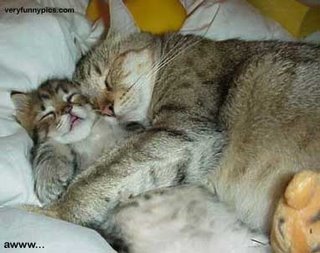Biting

Does your cat bite when he plays? Respond as a cat: hiss at him. Or scream in painful agony; he'll stop (though he might not play with you for a long while). I had a cat that accidentally drew blood while we were playing - I put my arm up to his nose and rubbed the droplets of blood against him, and he never bit again.
The Counters and Table
In our house, cats are allowed to get on the kitchen counter because that's the only way they can reach "their" two-shelf, rug-covered greenhouse window. They are not allowed on the kitchen table. It took 2 days to untrain Galahad and Stanley (for the previous 10 years, in a different household, they had been allowed on the kitchen table, even during meals). I simply picked them up, said "NO! You can't be on the table" and dropped them gently but firmly onto the floor. Some people resort to more intense retraining - spraying the cat with a water bottle, tossing it out of the room, etc., but use those as a last resort.
Stacking pots and pans near the edge of the counter, so they clatter and fall when the cat jumps up, will likely prevent him from jumping up in the future. You can also tape strips of velcro - the looped side on your counter temporarily; landing on the stiff loops may be uncomfortable enough to get your message across.
By the way, it took 2 days to convince Su-Su that she COULD now get up on the counter, after I installed the greenhouse window. I had to pick her up off the floor, put her on the counter, and gently nudge her toward it.
Scratching Furniture/Declawing
First, please note that declawing your cat so he won't scratch your furniture is cruel and inhumane. It is the equivalent of cutting off your finger up to the first knuckle. There can be serious physical and psychological effects.
First, please note that declawing your cat so he won't scratch your furniture is cruel and inhumane. It is the equivalent of cutting off your finger up to the first knuckle. There can be serious physical and psychological effects.

Instead, you should train your cat to use a scratching post. Other alternatives include a quick, painless trimming of his claws (which you can do at home using special clippers) or covering the claws with soft sheaths (which you can purchase relatively inexpensively).
Scratching is one of your cat's most ingrained instincts. Keep a scratching post near where the cat usually sleeps or, if he has already picked out a corner of your sofa, keep it next to that chosen spot. You may need to train your cat to use his scratching post. Do not pick him up and put his paws on the scratching post (that will only make him want to avoid it). Make the scratching post appealing to him: rub catnip on it or mist it with catnip spray; drape a heavy string (a long leather shoelace works great) over it and wiggle it to catch his interest; put treats on the very top.

Important: Invest in a scratching post that is 24" or 30" tall, with a sturdy base - your cat may be using the arm of the sofa because he can stretch higher than his scratching post will allow. Most of the ones you will find at the store are only 18" high so you may need to visit a pet supply store.
I recently found THE best scratching post for our cats! It's made out of rough sisal (NOT the rope, a weave!). It's tall (29 inches), doesn't fall over, doesn't wobble, and doesn't slide across the floor. And, of course, the best part: all the cats love it. It's called the TopCat Sisal Scratching Post.
A few cats don't like scratching on a vertical post, but will scratch willingly on a flat scratching pad. If your cat prefers a flat surface, you can either buy one of the cardboard scratching boxes (typically available from mail order or pet stores), or buy a scrap of plywood and a carpet remnant, large enough to fold around onto the back of the plywood. Cut the corners on an angle, fold the carpet remnant over the wood, and tack the carpet on using carpet tacks or heavy-duty staples.
Sometimes changing to a scratching post that is covered with sisal rope or a different texture will kindle his interest in the post, as well.
 An additional idea, one that worked well when there were more vacant rooms in the house, is to follow the instructions above for a flat-surface scratching pad, then mount it on the wall at a convenient height for the cat, in a hallway or in the laundry room.
An additional idea, one that worked well when there were more vacant rooms in the house, is to follow the instructions above for a flat-surface scratching pad, then mount it on the wall at a convenient height for the cat, in a hallway or in the laundry room. Other solutions: If he's scratching wood furniture, rub strong-smelling furniture polish into it. For sofa and chair sides, cover the edges of the sofa with heavy plastic (available at your local fabric store - typically used to cover footstools or protect tablecloths - you can buy twist-pins while you're there to hold the place neatly in place) or aluminum foil (use velcro or double-stick tape to hold in place). Or spray a cloth thoroughly with one of the sprays formulated for keeping a cat off the furniture, and pin it to the sofa, chair, or your speakers (don't spray directly onto the furniture). Or, put strips of self-adhesive velcro (loop side out) on the favored scratching spots. If all else fails, everytime you see him actively clawing the furniture, spray him lightly from a bottle of water (do this only when he is actually scratching, not when he is approaching or leaving the furniture).
Source: http://www.xmission.com

















